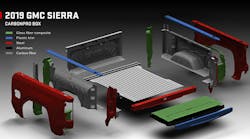The U.S. auto market is no longer the largest in the world, having been surpassed by China. However, it does lead the world in one thing: pickup trucks. No one loves a large pickup truck the way Americans do. While many may consider the pickup truck a crude, agricultural implement, over the past two decades it has become anything but.
The humble pickup bed would seem like one of the last places you would look for cutting edge technology. After all, it’s just a box, right?
At January 2018’s Detroit Auto Show, Chevrolet introduced the new 2019 Silverado pickup with a reconfigured bed that gave it a 20% cargo volume advantage over its competitors. Then in March, General Motors’ premium truck brand, GMC, launched a version of the Sierra with an optional carbon fiber cargo box.
The redesigned Sierra brings with it a fascinating new bit of tech that, in addition to the lightweighting, may well play a key role in the future of mobility-as-a-service applications.
Breaking the Mold
Carbon fiber has been used in many high-performance vehicles for its combination of high strength and low weight, but its cost and manufacturing challenges have largely kept it out of mainstream vehicles. The highest-volume applications to date for carbon fiber have been on the BMW i3 and i8 plug-in EVs.
However, while BMW and its carbon supplier, SGL, have made advances in bringing down cost and improving reparability, they continue to use the same fundamental process that has always been used for making parts. That process lies down a woven carbon fiber matte in a mold infused with plastic resin, which is then cured in a large autoclave to produce rigid thermoset components. This process has a cycle time of 45 minutes or more.
GMC and supplier Continental Structural Plastics are breaking the mold by using a sheet molding compound (SMC) process that replaces the glass fibers that have long been used with carbon fibers. Rather than a large woven matte that requires long, costly strands of fiber, SMC infuses the plastic resin with millions of short strands that are about 1 inch long. An SMC carbon fiber panel can be also be produced in about one minute and requires no autoclave curing. GMC showed a video of a carbon fiber pickup box being subjected to the sort of abuse a work truck goes through and it survived with no issue.
Thinking Outside of the Box—Environmental Impacts from SMCs
While it is great that GMC has a pickup box that saves 62 pounds over the steel equivalent and should be more durable, there are perhaps more important long-term implications of this new material technology. For instance, SMC could be incorporated into GM’s aggressive commitment to both zero emissions and automated vehicles. Automated vehicles are expected to be primarily utilized in mobility as a service (MaaS) applications, where vehicles will have much higher utilization and potentially shorter service life. Rather than scrapping MaaS vehicles every 3-4 years and expending energy to build replacements, a new vehicle architecture that utilizes carbon SMC structures with replaceable and upgradable components could prove to be far more efficient.
Navigant Research’s Mobility as a Service report projects 7.8 million automated MaaS vehicles could be deployed in 2026. If these vehicles can utilize a lower cost from a durable carbon fiber SMC structure, they could potentially remain in service for two to three decades with regular updates to propulsion, battery, sensing and computing systems. When the SMCs eventually have outlived their usefulness, they can be ground up and remanufactured into something new.
Today’s trucks are test beds for new technology, and the profits from their sales fund the development of tomorrow’s advanced vehicles.
A former automotive engineer, Sam Abuelsamid is a senior analyst in transportation efficiencies with Navigant Research, a team of market researchers providing in-depth analysis and insights focused on global clean technology markets.
This article was originally published in the Navigant Research blog.




